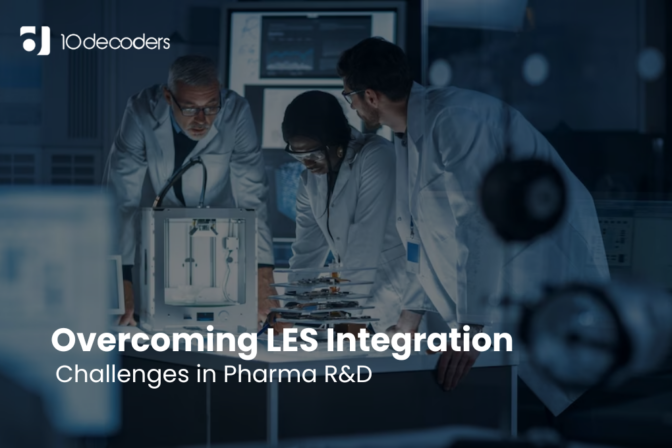Overcoming LES Integration Challenges in Pharma R&D
In the high-stakes world of pharmaceutical research and development (R&D), efficiency and accuracy are paramount. Every experiment, every data point, holds the potential to unlock life-saving breakthroughs. Yet, despite advances in automation and digitalization, a critical roadblock often impedes progress: the fragmented nature of laboratory data. Enter the Laboratory Execution System (LES), a powerful tool designed to orchestrate laboratory workflows. However, integrating LES with other lab systems presents a series of challenges, hindering the seamless flow of information and impeding R&D efficiency. This blog delves into these challenges and explores potential solutions, paving the way for a future of integrated data harmony in pharma R&D.
The Data Dissonance: Challenges in LES Integration
- Heterogeneous Systems and Data Formats: The pharmaceutical landscape is often a patchwork of legacy systems and instruments from diverse vendors. Each system speaks its own language, utilising different data formats and communication protocols. Integrating LES with this menagerie of systems becomes a complex puzzle, requiring custom interfaces and costly interoperability solutions.
- Data Silos and Lack of Standardization: Even within individual labs, data often resides in isolated silos, trapped within instruments, spreadsheets, and LIMS (Laboratory Information Management System). This lack of standardisation creates barriers to data exchange, hindering the holistic analysis crucial for effective R&D.
- Validation and Regulatory Compliance: Integrating new systems raises concerns about data integrity and compliance with stringent regulatory requirements. Ensuring data accuracy and traceability throughout the integrated environment presents a significant challenge.
User Adoption and Change Management: Introducing new workflows and technologies often encounters resistance from lab personnel accustomed to established processes. Integrating LES effectively requires robust training, support, and change management strategies to ensure user buy-in and successful adoption.
The Need for Integration: Breaking Down Data Silos
LES serves as the central hub for orchestrating laboratory workflows, managing sample logistics, and capturing experimental data. Yet, traditionally, they operate in isolation, acting as data silos amidst a sea of other vital lab systems like LIMS (laboratory information management systems), ELNs (electronic laboratory notebooks), and analytical instruments. This disconnect leads to
- Data Redundancy and Inconsistency: Duplication of data entry across systems wastes time and increases the risk of errors and inconsistencies, hindering downstream analysis and decision-making.
- Limited Visibility and Accessibility: Fragmented data hampers real-time insights and collaboration, slowing down research progress and hindering effective resource allocation.
- Manual Data Transfer and Validation: The laborious process of transferring data between LES and other systems is prone to errors and delays, jeopardising data integrity and compliance.
Harmonising the Symphony: Solutions for seamless LES Integration
- Standardised Data Formats and Communication Protocols: Embracing industry-wide standards like CDISC (Clinical Data Interchange Standards Consortium) and W3C-XML for data exchange simplifies integration with diverse systems and facilitates seamless data flow.
- Open Integration Platforms: Implementing open-source or vendor-neutral integration platforms provides a flexible and cost-effective approach for connecting LES with various lab systems. These platforms eliminate the need for custom interfaces and enable easier upgrades and scaling.
- Data Governance and Validation Strategies: Establishing robust data governance policies and implementing automated validation tools ensures data integrity and compliance throughout the integrated environment. This builds trust and confidence in the data, empowering informed decision-making.
- User-Centric Design and Training: Designing LES integrations with user needs in mind, coupled with comprehensive training programs and ongoing support, fosters user adoption and minimises resistance to change. This ensures smoother transitions and maximises the benefits of integration.
The Future of Pharma R&D: A Data-Driven Symphony
Overcoming the challenges of LES integration unlocks a future of data-driven transformation in pharma R&D. Imagine a world where
- Real-time data access: Scientists can access accurate and complete data from any experiment across various lab systems, enabling swift analysis and faster decision-making.
- Predictive analytics and machine learning: Integrated data empowers AI-driven algorithms to predict experimental outcomes, optimise workflows, and accelerate the discovery of new drugs.
- Collaborative R&D: Seamless data sharing across labs and organisations fosters deeper collaboration, accelerating research progress and shortening the path to life-saving solutions.
- Enhanced compliance and transparency: Rigorous data governance and validation ensure regulatory compliance and build trust in the research process, leading to greater transparency and public confidence.
Conclusion: The Integration Imperative
Integrating LES with other lab systems is not merely a technological endeavour; it represents a strategic shift towards a data-driven future in pharma R&D. By embracing open standards, prioritising user needs, and implementing robust data governance strategies, we can overcome the challenges of integration and unlock the symphony of scientific discovery. In a world where every day holds the promise of a new treatment, a new cure, integrating LES is not just an option; it’s an imperative. Let us rise to the challenge, harmonise the data dissonance, and orchestrate a future of seamless innovation in the pursuit of healthier lives for all.



